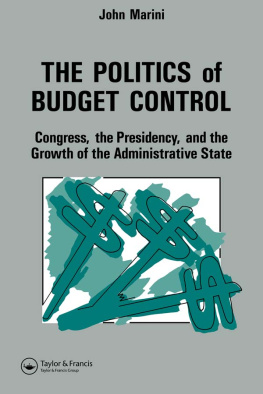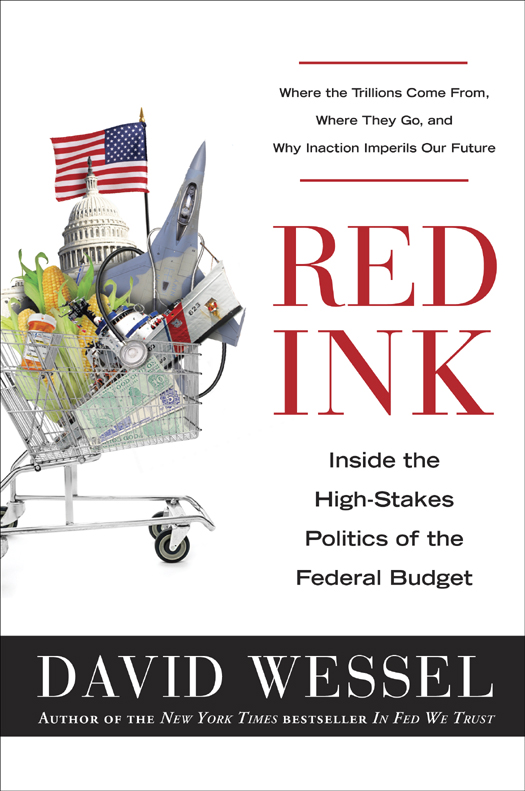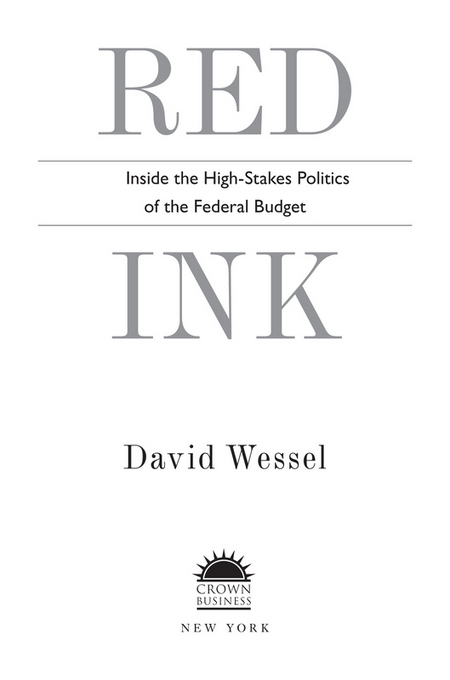ALSO BY DAVID WESSEL
In Fed We Trust
Prosperity (with Bob Davis)
Copyright 2012 by David Wessel
All rights reserved.
Published in the United States by Crown Business, an imprint of the Crown Publishing Group, a division of Random House, Inc., New York.
www.crownpublishing.com
CROWN BUSINESS is a trademark and crown and the Rising Sun colophon are registered trademarks of Random House, Inc.
Library of Congress Cataloging-in-Publication Data
Wessel, David.
Red ink: inside the high-stakes politics of the federal budget / David Wessel.
p. cm.
1.BudgetUnited States. 2. Budget deficitsUnited States. 3. Deficit financingUnited States. 4. Debts, PublicUnited States. I. Title.
HJ2051.W427 2012
336.73dc23 2012011819
eISBN: 978-0-7704-3615-5
Illustrations by Nelson Hsu
Jacket design by Laura Duffy
Jacket photographs: Getty Images:
(corn) Burazin; (jet) Tim Ridley; (flag) C Squared Studios;
(stethoscope) Jules Frazier; (cart) James Worrell;
(food stamps) Brand X Pictures; (Capitol) Imagemore Co., Ltd.;
(prescription bottle) Don Farrall; (ship) Stocktrek Images
v3.1
FOR JULIA AND BEN
CONTENTS

CHAPTER 1
SPENDING $400 MILLION AN HOUR
CHAPTER 2
HOW WE GOT HERE
CHAPTER 3
WHERE THE MONEY GOES
CHAPTER 4
WHERE THE MONEY COMES FROM
CHAPTER 5
WHY THIS CANT GO ON FOREVER
CHAPTER 1

SPENDING $400 MILLION AN HOUR
I n the cold predawn darkness of Monday, February 13, 2012, Robert Friedlander walked into a Starbucks three blocks from the White House. As they had been instructed by email the night before, a half dozen reporters were waiting for himone each from Dow Jones, Bloomberg, Reuters, Associated Press, Politico, and the Washington Post. With no ceremony and not much conversation, the young White House budget office aide slipped each of them a CD in a plain, square white envelope. The contents: President Barack Obamas budget for the coming fiscal year. Its embargoed until 11:15, he said. Friedlanders inside-the-Beltway shorthand meant the reporters had about five hours to scour the documents before publishing stories on newswires and websites. At 11:15 a.m., the president was to begin speaking about the budget at a northern Virginia community college.
Every president since Warren Harding has been required by law to send an annual budget to Congress. Its the only time that the chief executive of the United States has to make his promises add up. The modern version comes in three formats: free online, $27 for the CD, or $218 for the printed four-volume paperback set. The budget is one part rhetoric by the party in power that highlightsdepending on the timesthe governments largesse or its tightfistedness. A second part details how the president would, if Congress went along, spend a sum equal to the value of all the goods and services produced by the 82 million people of Germany, the worlds fifth-largest economy. And in its modern form, a third part is dire prediction, a collection of uncomfortable, indisputable facts showing the unsustainable fiscal course the U.S. government is on.
The budget doesnt record what might have been. The document Obama released in February did not, for instance, acknowledge intense summertime talks the president had with Republican House Speaker John Boehner that failed to end a stalemate over spending and taxes. And for all its excruciating detail, the presidents budget doesnt ultimately settle anything; the Constitution gives Congress the power to tax and spend. But neither is presbudas its known to insiders on the congressional committees that decide how to spend taxpayers moneyirrelevant. The budget is the starting point for an annual round of maneuvering that ranges from high-minded debate about national priorities and hard choices to big-money lobbying and small favors for home-state constituents. The details buried in itwhich programs should live and which should die, which should get more and which should get lessoften become law.
Ultimately, the federal governments power comes in three forms: its physical force, both foreign and domestic; its ability to make and enforce rules that govern our lives; and its power to tax and spend. The budgetand this bookis about the third form. With far more precision than thirty-second sound bites or campaign stump speeches, the presidents budget and alternatives crafted by the opposition in Congress reflect contrasting visions for the size of government in America and the role it plays in the economy. How strong and generous a safety net should government provide to the poor? How much should taxpayers invest in medical research? How hard should government lean against market forces that are widening the gap between winners and losers in the economy? How much should spending be cut to rein in the deficit, and how much should taxes be raised, if at all?
Anyone in Washington who is serious about trying to steer the government to the right or to the left understands the power and import of decisions on taxes and spending embodied in the budget. Among them are Jack Lew and Paul Ryan, both steeped in fiscal details big and small. The two illustrate the competing visions for government and the use of the budget as an important, perhaps the only important, way to achieve them. As director of the White House Office of Management and Budget, Lew, fifty-six, put the finishing touches on Obamas February plan just as the president named him White House chief of staff. Ryan, forty-two, a Republican congressman from Wisconsin and the chairman of the House Budget Committee, promptly criticized the Obama budgetbroken promises, failed leadership and a diminished future, he saidand set to work on an alternative.
Jacob Jack Lew got his start in politics in 1968, at age twelve, as a volunteer for antiVietnam War presidential candidate Eugene McCarthy. Lew has never run for office, but he has been at the elbow of influential Democrats from the late House Speaker Tip ONeill and New York congresswoman Bella Abzug to Secretary of State Hillary Clinton and President Obama. An Orthodox Jew who avoids working on Friday nights and Saturdays except when duty calls, Lew is truly convinced of the governments power to do good. When he took over the budget office, he replaced the portrait of Alexander Hamilton that had been hung by his predecessor, Peter Orszag, with paintings of his native New York City done by artists working for the governments Works Progress Administration in the 1930s.
Lew is tall and lanky, his thick black hair just beginning to gray and his oval wire-rim glasses exactly what one would expect of a budget wonk. But Lew, who also was budget director for Bill Clinton, is the sort of wonk who can say sincerely: I have a soft spot for Medicaidthe government health insurance program for the poor funded jointly by state and federal governmentsbecause its the thing thats easy for the political system to mischaracterize.










